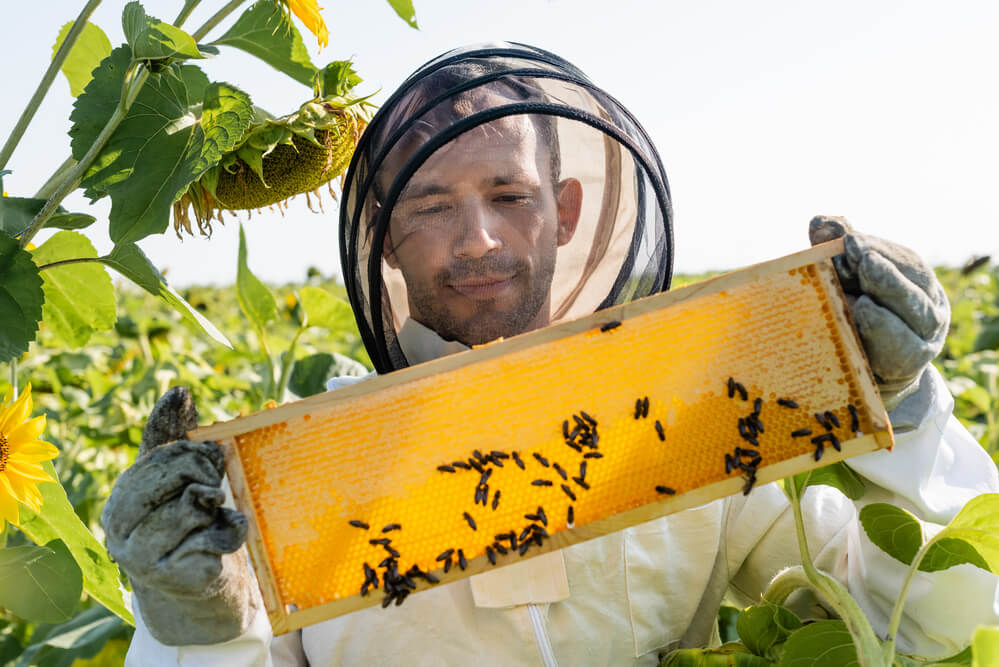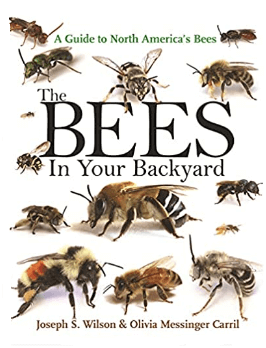Table of Contents:
Are Honey Bees Endangered?
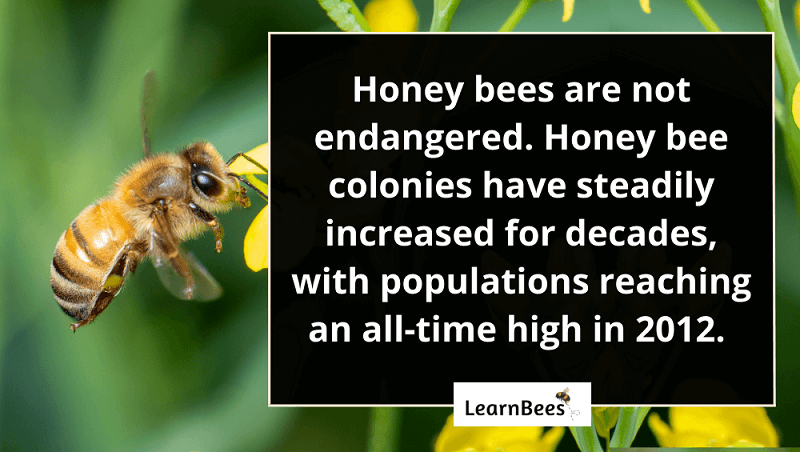
Honey bees are neither endangered nor at risk of becoming endangered.
Wait a minute.
Honey bees aren’t at risk of going extinct?
Not at all.
In fact, honey bee colonies in the U.S. have increased by a whopping 68% since the 1970s. Better yet, recent data shows there have been upwards of three million colonies registered in the United States alone.(1, 2)
And here’s the thing:
A single honey bee colony can contain more than 50,000 bees.
So if three million colonies are multiplied by 50,000 bees in each one, then we get a total of 150 billion honey bees.
Not only that?
These numbers only include honey bee colonies managed by beekeepers. They don’t include the wild honey bee colonies that roam freely across the U.S.
So fear not:
We’re not headed for a world without honey bees. Not even close.
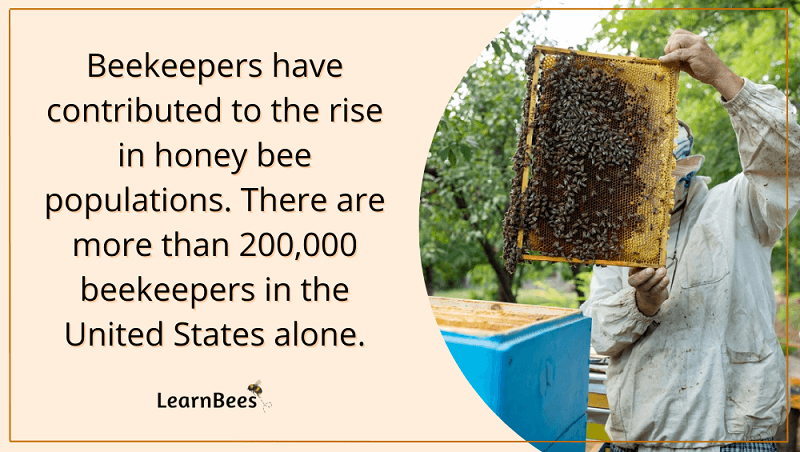
But fearmongering headlines still persist. Titles like: “Save the Honey Bees” and “The Honey Bee Apocalypse is Here” go viral every year.
Angelina Jolie even famously posed for Time magazine with the headline: “A World Without Bees: The Price We’ll Pay If We Don’t Figure Out What’s Killing the Honeybee.”
What gives?
Why do so many people believe we’re facing a honey bee apocalypse? Moreover, why do these false headlines get pitched to us in the first place?
We’ll talk more about that in a bit.
In the meantime, let’s talk about the bees that are truly at risk of extinction in the U.S.:
Native bees.
Native bees are bees that are born in North America. They occur naturally here and are well adapted to the climate and conditions. The American bumble bee (Bombus pensylvanicus) and rusty patched bumble bee (Bombus affinis) are two common native bee examples.
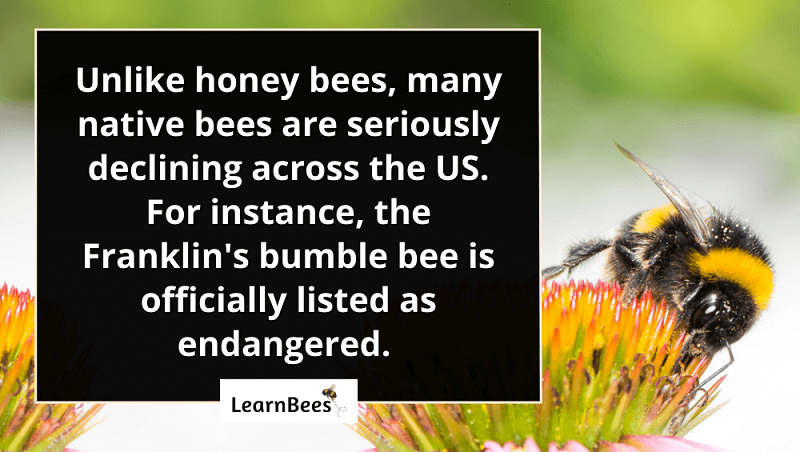
According to the Xerces Society of Conservation, rusty patched bumble bees have declined by 87% in recent years.(3)
As a result, the U.S. Fish and Wildlife Service (USFWS) has listed them under endangered status since 2017.(4, 5)
Speaking of bees native to North America…
Honey bees aren’t one of them.
Honey bees are only native to Europe, Asia, and Africa. But thanks to importation, honey bees can now be found on every continent except Antarctica.
Why is this important?
Because native bees are being out-competed by honey bees for food. Native bees depend on native flowers for pollen and nectar.
Manu Saunders, an entomologist and professor at the University of New England, said, “Increasing numbers of honey bees may be depleting resources that wild insects need, and spreading parasites and diseases to wild insects.”
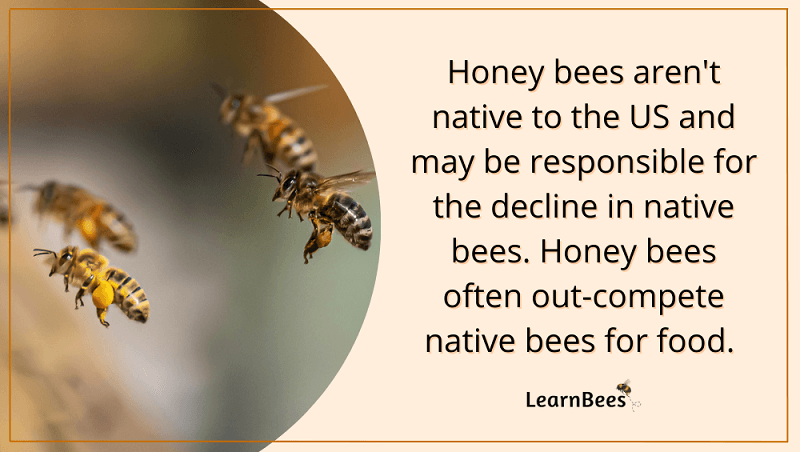
The issue, said Saunders, is that the honey bees in North America “could be harming wild insects in many places.”
“These [honey bee] colonies pull a huge amount of floral resources, like nectar and pollen, out of the wildlands,” added Stephen Buchmann, a pollination ecologist specializing in bees and an adjunct professor at the University of Arizona.
“This takes food out of the mouths of native bees and other pollinators,” said Buchmann.
Now don’t get me wrong.
Honey bees aren’t bad. It’s not their fault they’ve been imported all over the world. It’s not even their fault that they’re out-competing native bees for food.
Honey bees are simply surviving in the climates they’ve been placed in.
Who could blame them for that?
Now I know what you’re thinking:
We can’t blame the honey bees for being imported here, but we can most certainly blame the beekeepers. The more honey bees that beekeepers raise, the more native bees are in decline.
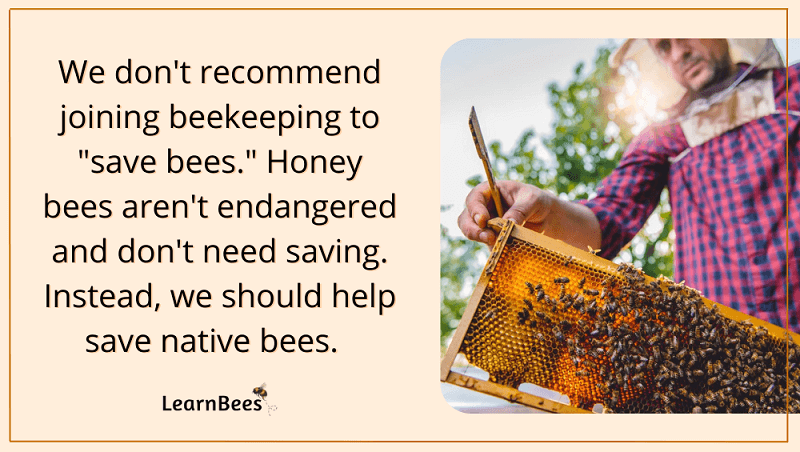
Unfortunately, things aren’t so black and white.
We must remember that beekeepers often join the hobby because they love bees. And they don’t just love honey bees, either. Most beekeepers develop an appreciation for many types of native bees, including bumble bees, mason bees, and carpenter bees.
What’s more:
Beekeepers tend to value and respect their local ecosystems more than the average person. As such, they use fewer chemicals, plant native flowers, and educate people about these valuable pollinators.
In turn, these things benefit native bees as well as honey bees.
With that said, I always caution people against beekeeping. Not only is beekeeping time-consuming and expensive, but we’ve already learned that increasing honey bee populations isn’t helping native bees.
So what can you do instead?
Let’s talk about that next.
How Can We Help Endangered Bees?
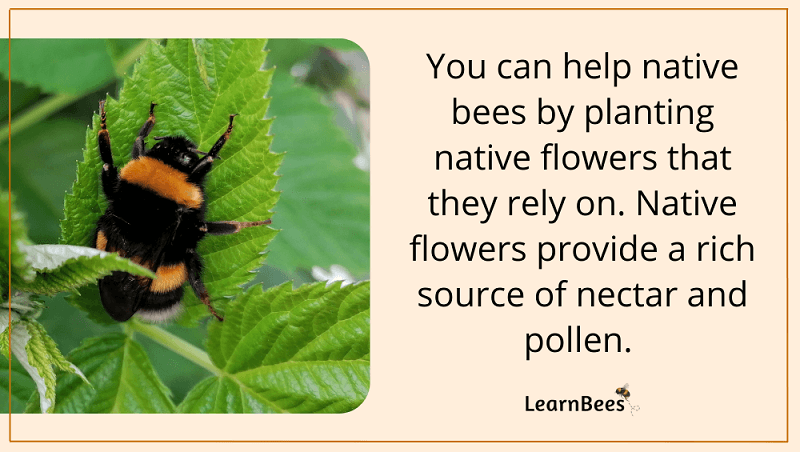
The best way to help endangered bees is to plant flowers native to your area.
We recommend using the Native Plant Finder to pick flowers to help bees and other pollinators like butterflies and moths.
Here’s why this is so important:
Native bees rely on native flowers to survive.
For example, the spring beauty miner bee (Andrena erigeniae) relies on spring beauty flowers to feed its baby bees. Similarly, squash bees (Peponapis pruinose) only feed their offspring using pollen and nectar from squash plants.
But just as important:
When you help native bees, you also help other native pollinators.
For instance, native milkweeds are the sole host plant for monarch butterflies. Without them, monarch butterflies don’t have a place to lay eggs, leading to a decline in their population.
But here’s the good news:
Milkweeds native to your area provide a host for monarchs while also providing a rich source of nectar and pollen for native bees.
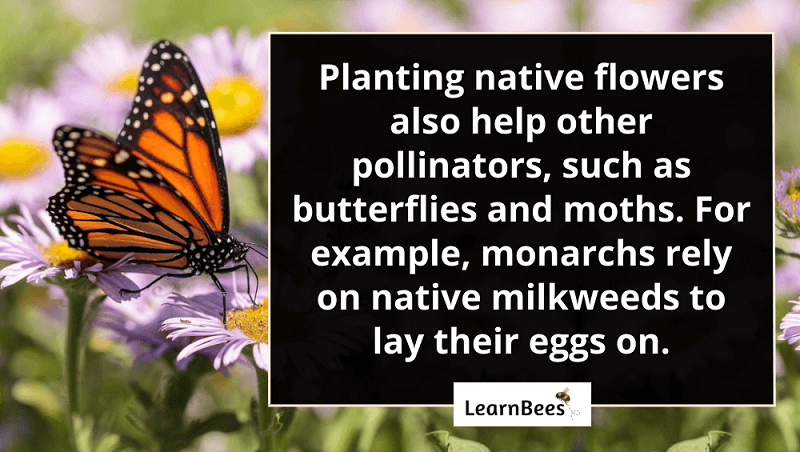
But remember:
Not all milkweeds or wildflowers are native to your area. It’s essential to avoid non-native plants. That’s why we recommend using the Native Plant Finder to help. You can also google native plants for your area.
To take it a step further?
Check out Doug Tallamy’s YouTube presentation on building a native pollinator garden.
Doug Tallamy is an entomologist, ecologist, and professor in the Department of Entomology at the University of Delaware. He’s authored the best-selling book, Nature’s Best Hope and has been featured on the popular Joe Gardener podcast.
But that’s not all.
You also can help endangered bees by using fewer chemicals around your yard.
This includes reducing the use of things like round-up or other weed killers. Bees and other pollinators experience declines when harsh chemicals are used. Additionally, chemicals used by pest control companies to kill mosquitos can also kill pollinators.
Not good.
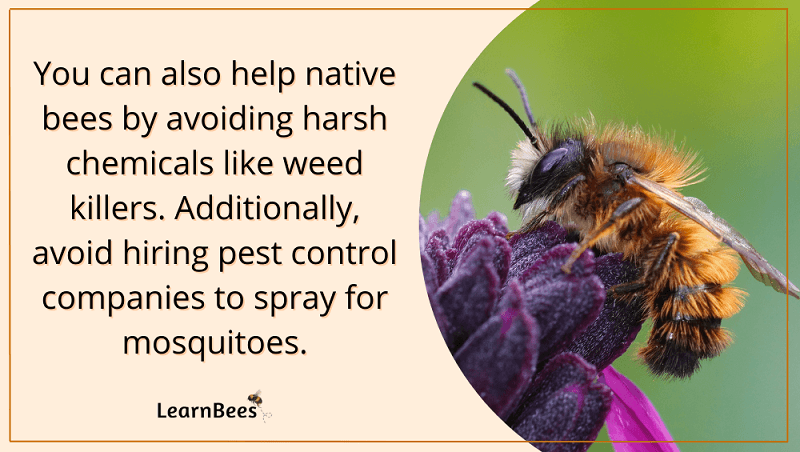
Last but not least?
Don’t buy bees online. Many online retailers offer “buy and release” kits that sell native bees.
In turn, people buy these bees because they believe they’re helping the native bee populations.
However, they are not.
You want to attract native bees already adapted to your local climate instead of buying bees online. Shipping bees across the country forces them to live where they’re not properly adapted. For instance, native bees shipped from a hot, dry climate will likely not thrive if sent to a cool, wet climate.
To add insult to injury?
Moving bees around the country also moves parasites and diseases along with them. The diseases from these bees can wreak havoc on your local ecosystem.
So, what should you do?
Plant native flowers and avoid using harsh chemicals. Even small gardens can go a long way in helping your local bee populations.
Why Do People Believe Honey Bees Are Endangered?
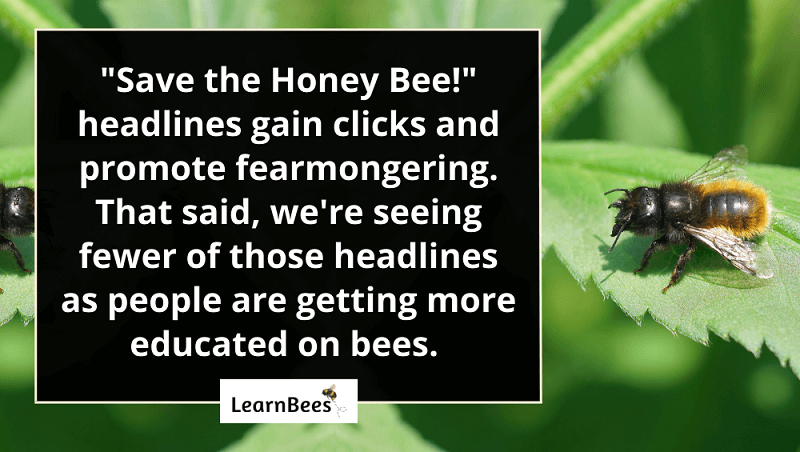
Unfortunately, the idea that honey bees are endangered still persists in the mainstream media. Tantalizing headlines and “Save the Honey Bee!” campaigns spread like wildfire around the United States.
Fortunately, we’re seeing fewer of these headlines as more people are educated about honey bees.
But there is still a lot of misinformation out there.
For example, there is a lot of confusion surrounding “colony losses.” Colony losses occur when a honey bee colony doesn’t survive. This can happen for several reasons, including weather and diseases.
With that said, most colony losses occur during the winter. This is natural.
Honey bee populations naturally decline during cold weather and bounce back come spring. A queen honey bee can lay up to 2,000 eggs per day during the warm months.
In addition, other media outlets cite “Colony Collapse Disorder” as a critical problem facing honey bees. Colony Collapse Disorder is a phenomenon that happens when the majority of worker bees in a bee colony vanish and leave behind only their queen.
However, the bee hysteria following Colony Collapse Disorder (CCD) isn’t warranted.
Reported cases of CCD have decreased substantially over the years, and they don’t pose a serious threat to honey bees.
FAQs on “Are Honey Bees Endangered?”
- Are honey bees endangered in the United States?
- Are bumble bees endangered?
- Are honey bees invasive?
- How many species of bees are endangered?
- Are bees going extinct?
Are honey bees endangered in the United States?
Honey bees are not endangered in the United States. Instead, native bees like the rusty patched bumble bee (Bombus affinis) are endangered.
It’s important to remember that honey bees aren’t native to the United States. They were brought over from Europe by early settlers in the 1600s. Unfortunately, honey bee colonies are large and demand a lot of resources. One honey bee colony can have upwards of 50,000 bees in it.
This means honey bee colonies have thousands of mouths to feed and intense competition for flowers. As a result, native bees often lose out to honey bees.
—> Go back to the FAQs on “Are Honey Bees Endangered?”
More to Explore:
- How to Repel Bees Without Killing Them
- Carpenter Bee vs. Bumble Bee
- The Best Essential Oils for Bee Stings
Are bumble bees endangered?
There are 49 bumble bee species in the U.S., and not all are considered endangered. The Franklin’s bumble bee (Bombus franklin) and the rusty patched bumble bee (Bombus affinis) are the only two species listed as endangered.
However, many are experiencing serious declines – despite not yet being classified on the dangered list.
The American bumble bee isn’t technically considered endangered yet, but its population has plummeted by nearly 90% over the years. As such, the American bumble bee is currently being petitioned to receive protection under the Endangered Species Act.
—> Go back to the FAQs on “Are Honey Bees Endangered?”
More to Explore:
Are honey bees invasive?
Honey bees are considered invasive by some and non-invasive by others.
The dictionary defines an invasive organism as “One that has arrived in a place from somewhere else and has a harmful effect on that place.”
Honey bees offer both harmful and negative effects on North America. They provide pollination services to farmers across the country, but they also contribute to the major declines in native bee populations.
Native bees like bumble bees and mason bees are incredible pollinators. In fact, it takes only 400 mason bees to do the pollination work of 40,000 honey bees.
However, honey bees are used by farmers because they live in large colonies and are easy to transport. They’re also generalist feeders, meaning they collect pollen and nectar from many types of crops.
—> Go back to the FAQs on “Are Honey Bees Endangered?”
More to Explore:
How many species of bees are endangered?
So far, eight bee species have been officially added to the endangered list. This number may increase in the future as certain bee populations experience declines.
—> Go back to the FAQs on “Are Honey Bees Endangered?”
More to Explore:
Are bees going extinct? When will bees go extinct?
Not all bees are going extinct, but some species are endangered due to declining populations. Franklin’s bumble bee is a common example of an endangered bumble bee.
